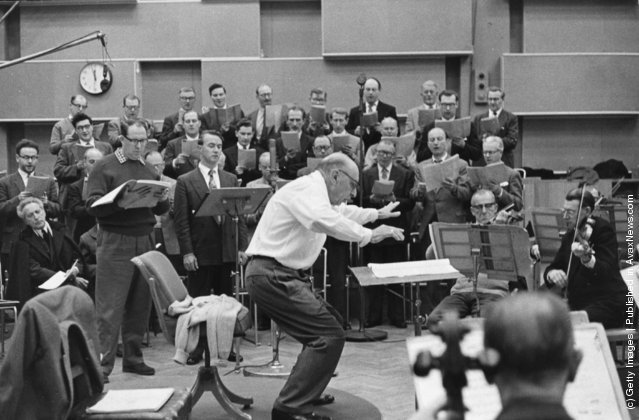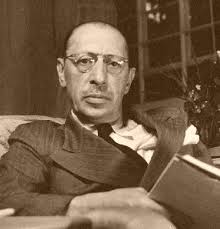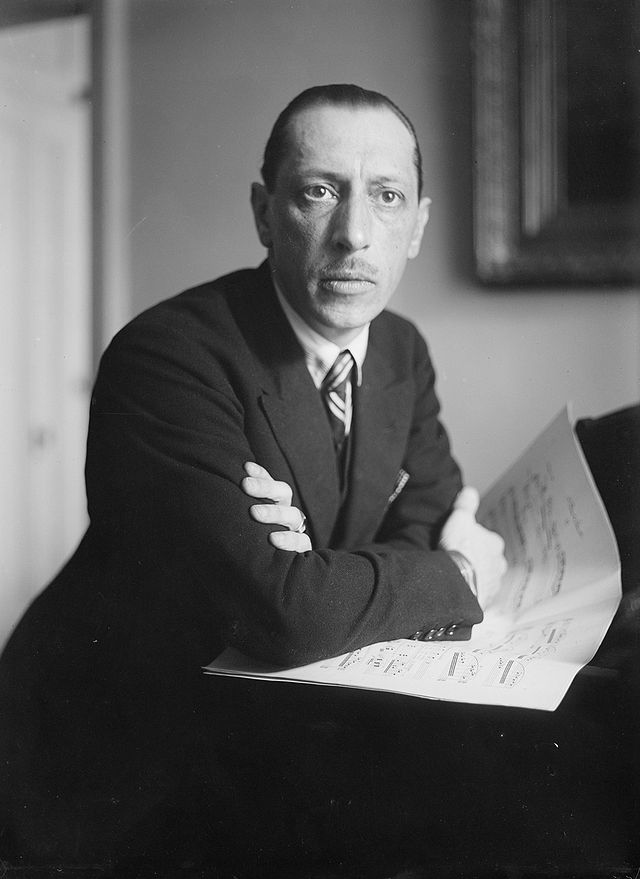- Profession: Composer.
- Residences: Paris.
- Relation to Mahler:
- Correspondence with Mahler:
- Born: 17-06-1882 Oranienbaum, Lomonosov, St Petersburg, Russia.
- Died: 06-04-1971 New York, America.
- Buried: Isola di San Michele, Venice, Italy. Close to Diagilev. His father is buried at Tikhvin cemetery.
Igor Fyodorovich Stravinsky (sometimes spelled Strawinski, Strawinsky, Stravinskii, Igor’ Fëdorovic Stravinskij) was a Russian (and later, a naturalized French and American) composer, pianist and conductor. He is widely considered one of the most important and influential composers of the 20th century.
Stravinsky’s compositional career was notable for its stylistic diversity. He first achieved international fame with three ballets commissioned by the impresario Sergei Diaghilev and first performed in Paris by Diaghilev’s Ballets Russes: The Firebird (1910), Petrushka (1911) and The Rite of Spring (1913). The last of these transformed the way in which subsequent composers thought about rhythmic structure and was largely responsible for Stravinsky’s enduring reputation as a musical revolutionary who pushed the boundaries of musical design. His “Russian phase” was followed in the 1920s by a period in which he turned to neoclassical music.
The works from this period tended to make use of traditional musical forms (concerto grosso, fugue and symphony). They often paid tribute to the music of earlier masters, such as J.S. Bach and Tchaikovsky. In the 1950s, Stravinsky adopted serial procedures. His compositions of this period shared traits with examples of his earlier output: rhythmic energy, the construction of extended melodic ideas out of a few two- or three-note cells and clarity of form, of orchestration and of utterance.
Early life in the Russian Empire
Stravinsky was born on 17 June 1882 in Oranienbaum, a suburb of St Petersburg, the Russian imperial capital and was brought up in St Petersburg. His parents were Fyodor Stravinsky, a bass singer at the Mariinsky Theatre in St Petersburg, and Anna (née Kholodovsky). His great-great-grandfather, Stanislaw Strawinski, was of Polish noble descent, of the Strawinski family of Sulima. According to Igor Stravinsky, the name “Stravinsky” (Polish: Strawinski) originated from “Strava” (Polish: Strawa), a small river in eastern Poland, tributary to the Vistula. He recalled his schooldays as being lonely, later saying that “I never came across anyone who had any real attraction for me”. Stravinsky began piano lessons as a young boy, studying music theory and attempting composition. In 1890, he saw a performance of Tchaikovsky’s ballet The Sleeping Beauty at the Mariinsky Theater. By age fifteen, he had mastered Mendelssohn’s Piano Concerto in G minor and finished a piano reduction of a string quartet by Glazunov, who reportedly considered Stravinsky unmusical, and thought little of his skills.
Despite his enthusiasm for music, his parents expected him to study law. Stravinsky enrolled at the University of St Petersburg in 1901, but he attended fewer than fifty class sessions during his four years of study. In the summer of 1902 Stravinsky stayed with composer Nikolai Rimsky-Korsakov and his family in the German city of Heidelberg, where Rimsky-Korsakov, arguably the leading Russian composer at that time, suggested to Stravinsky that he should not enter the St Petersburg Conservatoire, but instead study composing by taking private lessons, in large part because of his age. Stravinsky’s father died of cancer that year, by which time his son had already begun spending more time on his musical studies than on law. The university was closed for two months in 1905 in the aftermath of Bloody Sunday: Stravinsky was prevented from taking his final law examinations and later received a half-course diploma in April 1906. Thereafter, he concentrated on studying music. In 1905, he began to take twice-weekly private lessons from Rimsky-Korsakov, whom he came to regard as a second father. These lessons continued until Rimsky-Korsakov’s death in 1908.
In 1905 he was betrothed to his cousin Yekaterina Gavrilovna Nosenko (called “Katya”), whom he had known since early childhood. In spite of the Orthodox Church’s opposition to marriage between first cousins, the couple married on 23 January 1906: their first two children, Fyodor (Theodore) and Ludmila, were born in 1907 and 1908, respectively. In February 1909, two orchestral works, the Scherzo fantastique and Feu d’artifice (Fireworks) were performed at a concert in St Petersburg, where they were heard by Sergei Diaghilev, who was at that time involved in planning to present Russian opera and ballet in Paris. Diaghilev was sufficiently impressed by Fireworks to commission Stravinsky to carry out some orchestrations and then to compose a full-length ballet score, The Firebird.
Life in Switzerland
Stravinsky became an overnight sensation following the success of The Firebird’s premiere in Paris on 25 June 1910. The composer had travelled from his estate in Ustilug, Ukraine, to Paris in early June to attend the final rehearsals and the premiere of The Firebird. His family joined him before the end of the ballet season and they decided to remain in the West for a time, as his wife was expecting their third child. After spending the summer in La Baule, Brittany, they moved to Switzerland in early September. On the 23rd, their second son Sviatoslav Soulima was born at a maternity clinic in Lausanne; at the end of the month, they took up residence in Clarens. Over the next four years, Stravinsky and his family lived in Russia during the summer months and spent each winter in Switzerland. During this period, Stravinsky composed two further works for the Ballets Russes: Petrushka (1911), and Le Sacre du printemps (The Rite of Spring; 1913).
Shortly following the premiere of The Rite of Spring, Stravinsky contracted typhoid from eating bad oysters, and was confined to a Paris nursing home, unable to depart for Ustilug until 11 July. During the remainder of the summer, Stravinsky turned his attention to completing his first opera, The Nightingale (usually known by its French title Le Rossignol), which he had begun in 1908 (that is, before his association with the Ballets Russes). The work had been commissioned by the Moscow Free Theatre for the handsome fee of 10,000 roubles.

The Stravinsky family returned to Switzerland (as usual) in the fall of 1913. On 15 January 1914, a fourth child, Marie Milène (or Maria Milena), was born in Lausanne. After her delivery, Katya was discovered to have tuberculosis and confined to the sanatorium at Leysin, high in the Alps. Igor and the family took up residence nearby and he completed Le Rossignol there on 28 March In April, they were finally able to return to Clarens. By then, the Moscow Free Theatre had gone bankrupt. As a result, Le Rossignol was first performed under Diaghilev’s auspices at the Paris Opéra on 26 May 1914, with sets and costumes designed by Alexandre Benois. Le Rossignol enjoyed only lukewarm success with the public and the critics, apparently because its delicacy did not meet their expectations of the composer of The Rite of Spring. However, composers including Maurice Ravel, Béla Bartók, and Reynaldo Hahn found much to admire in the score’s craftsmanship, even alleging to detect the influence of Arnold Schoenberg.
In July, with war looming, Stravinsky made a quick trip to Ustilug to retrieve personal effects including his reference works on Russian folk music. He returned to Switzerland just before national borders closed following the outbreak of World War I. The War and subsequent Russian Revolution made it impossible for Stravinsky to return to his homeland, and he did not set foot upon Russian soil again until October 1962. In June 1915, Stravinsky and his family moved from Clarens to Morges, a town 6 miles south-west of Lausanne on the shore of Lake Geneva. The family continued to live there (at three different addresses) until 1920.
Stravinsky struggled financially during this period. Russia (and its successor, the USSR) did not adhere to the Berne convention and this created problems for Stravinsky when collecting royalties for the performances of all his Ballets Russes compositions. Stravinsky blamed Diaghilev for his financial troubles, accusing him of failing to live up to the terms of a contract they had signed. He approached the Swiss philanthropist Werner Reinhart for financial assistance during the time he was writing Histoire du soldat (The Soldier’s Tale). Reinhart sponsored and largely underwrote its first performance, conducted by Ernest Ansermet on 28 September 1918 at the Théâtre Municipal de Lausanne. In gratitude, Stravinsky dedicated the work to Reinhart and gave him the original manuscript. Reinhart supported Stravinsky further when he funded a series of concerts of his chamber music in 1919: included was a suite from Histoire du soldat arranged for violin, piano and clarinet, which was first performed on 8 November 1919, in Lausanne. In gratitude to his benefactor, Stravinsky also dedicated his Three Pieces for Clarinet (October–November 1918) to Reinhart, who was an excellent amateur clarinetist.
Life in France
Following the premiere of Pulcinella by the Ballets Russes in Paris on 15 May 1920, Stravinsky returned to Switzerland. On 8 June, the entire family left Morges for the last time, and moved to the fishing village of Carantec in Brittany for the summer while also seeking a new home in Paris. On hearing of their dilemma, couturière Coco Chanel invited Stravinsky and his family to reside at her new mansion “Bel Respiro” in the Paris suburb of Garches until they could find a more suitable residence; they arrived during the second week of September. At the same time, Chanel also guaranteed the new (December 1920) Ballets Russes production of Stravinsky’s Le Sacre du Printemps (The Rite of Spring) with an anonymous gift to Diaghilev, said to have been 300,000 francs.
Stravinsky formed a business and musical relationship with the French piano manufacturing company Pleyel. Pleyel essentially acted as his agent in collecting mechanical royalties for his works and provided him with a monthly income and a studio space at its headquarters in which he could work and entertain friends and business acquaintances. Under the terms of his contract with the company, Stravinsky agreed to arrange (and to some extent re-compose) many of his early works for the Pleyela, Pleyel’s brand of player piano. He did so in a way that made full use of all of the piano’s eighty-eight notes, without regard for human fingers or hands. The rolls were not recorded, but were instead marked up from a combination of manuscript fragments and handwritten notes by Jacques Larmanjat, musical director of Pleyel’s roll department. Among the compositions that were issued on the Pleyela piano rolls are The Rite of Spring, Petrushka, The Firebird and Song of the Nightingale. During the 1920s, Stravinsky recorded Duo-Art rolls for the Aeolian Company in both London and New York, not all of which have survived.
Patronage was never far away. In the early 1920s, Leopold Stokowski gave Stravinsky regular support through a pseudonymous ‘benefactor’. Stravinsky met Vera de Bosset in Paris in February 1921, while she was married to the painter and stage designer Serge Sudeikin, and they began an affair that led to Vera leaving her husband.
In May 1921, Stravinsky and his family moved to Anglet, near Biarritz, in the south of France. From then until his wife’s death in 1939, Stravinsky led a double life, dividing his time between his family in southern France, and Vera in Paris and on tour. Katya reportedly bore her husband’s infidelity “with a mixture of magnanimity, bitterness, and compassion”. In September 1924, Stravinsky bought “an expensive house” in Nice: the Villa des Roses.
- See photo 1926 with Willem Mengelberg (1871-1951) in Amsterdam.
The Stravinskys became French citizens in 1934 and moved to the rue du Faubourg St-Honoré in Paris. Stravinsky later remembered this last European address as his unhappiest, as his wife’s tuberculosis infected both himself and his eldest daughter Ludmila, who died in 1938. Katya, to whom he had been married for 33 years, died of tuberculosis a year later, in March 1939. Stravinsky himself spent five months in hospital, during which time his mother died. During his later years in Paris, Stravinsky had developed professional relationships with key people in the United States: he was already working on his Symphony in C for the Chicago Symphony Orchestra and he had agreed to deliver the prestigious Charles Eliot Norton Lectures at Harvard University during the 1939–40 academic year.
Life in the United States
Despite the outbreak of World War II on 1 September 1939, the widowed Stravinsky sailed (alone) for the United States at the end of the month, arriving in New York City and thence to Cambridge, Massachusetts, to fulfill his engagement at Harvard. Vera followed him in January, and they were married in Bedford, Massachusetts, on 9 March 1940. Stravinsky settled in West Hollywood. He spent more time living in Los Angeles than any other city. He became a naturalized United States citizen in 1945.
Stravinsky had adapted to life in France, but moving to America at the age of 57 was a very different prospect. For a while, he maintained a circle of contacts and emigré friends from Russia, but he eventually found that this did not sustain his intellectual and professional life. He was drawn to the growing cultural life of Los Angeles, especially during World War II, when so many writers, musicians, composers and conductors settled in the area: these included Otto Klemperer, Thomas Mann, Franz Werfel, George Balanchine and Arthur Rubinstein. Bernard Holland claimed Stravinsky was especially fond of British writers, who visited him in Beverly Hills, “like W. H. Auden, Christopher Isherwood, Dylan Thomas. They shared the composer’s taste for hard spirits – especially Aldous Huxley, with whom Stravinsky spoke in French”. Stravinsky and Huxley had a tradition of Saturday lunches for west coast avant-garde and luminaries.

Stravinsky’s unconventional dominant seventh chord in his arrangement of “The Star-Spangled Banner” led to an incident with the Boston police on 15 January 1944, and he was warned that the authorities could impose a $100 fine upon any “rearrangement of the national anthem in whole or in part”. The incident soon established itself as a myth, in which Stravinsky was supposedly arrested for playing the music. A widely known photograph of Stravinsky, supposedly his mug shot, has been shown to be for a passport application. Stravinsky’s professional life encompassed most of the 20th century, including many of its modern classical music styles, and he influenced composers both during and after his lifetime. In 1959, he was awarded the Sonning Award, Denmark’s highest musical honour. In 1962, he accepted an invitation to return to Leningrad for a series of concerts. During his stay in the USSR, he visited Moscow and met several leading Soviet composers, including Dmitri Shostakovich and Aram Khachaturian.
In 1969, Stravinsky moved to the Essex House in New York, where he lived until his death in 1971 at age 88 of heart failure. He was buried at San Michele, close to the tomb of Diaghilev.

